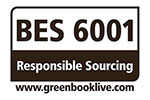01732 360 095
When tasked with designing a waterproofing solution for below-ground structures, it is important that the design should adhere to prevalent industry recommendations.

However, the path to delivering an internal environment that is fit for its intended use is strewn with numerous and varying product options, one of the most contentious being how to achieve a watertight structure using concrete.
Toby Champion of Newton Waterproofing Systems examines the requirements of industry guidelines regarding concrete as a standalone waterproof solution.
When considering the influence of industry recommendations on any waterproofing project, both BS 8102:2022(1) and NHBC Chapter 5.4(2) define three types of waterproofing:
- Type A – Barrier protection: the structure has no integral protection against water and relies on an internal or external membrane.
- Type B – Integral protection: the structure itself is designed to be integrally waterproof.
- Type C – Drained protection: it is accepted that water could enter the structure and an internal cavity drainage system is used to depressurise and manage the water.
Based on these, the British Standard recommends that combining two or more waterproofing types should be considered when:
- the assessed risks are deemed to be high; or
- the consequences of failure to achieve the required internal environment are deemed too high.
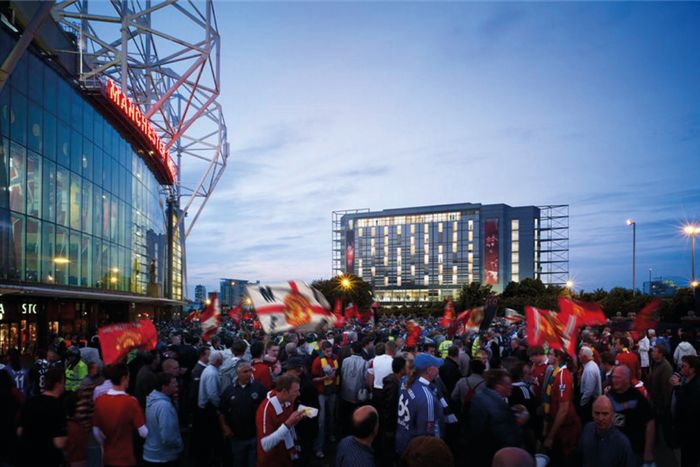 The Hotel Football in Manchester is one example of an extensive concrete structure that used Newton Type A, B and C systems, achieving complete waterproofing.
The Hotel Football in Manchester is one example of an extensive concrete structure that used Newton Type A, B and C systems, achieving complete waterproofing.
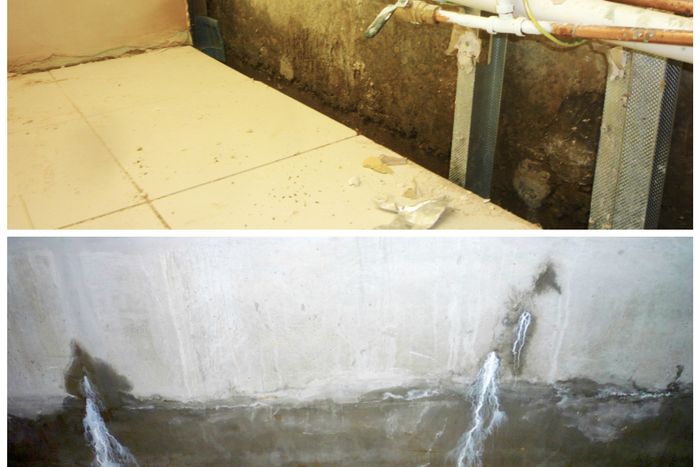 No matter how good the concrete and placement, leaks can still occur at the construction joints and cracks, causing significant damage to internal finishes.
No matter how good the concrete and placement, leaks can still occur at the construction joints and cracks, causing significant damage to internal finishes.
However, the required internal environment also influences whether combined waterproofing systems should be used, and the British Standard categorises potential internal environments into three grades:
- Grade 1a – Seepage and damp areas from internal and external sources are tolerable, where this does not impact on the proposed use of below ground structure.
- Grade 1b – No seepage. Damp areas from internal and external sources are tolerable.
- Grade 2 – No seepage is acceptable. Damp areas as a result of internal air moisture/condensation are tolerable; measures might be required to manage water vapour/condensation.
- Grade 3 – No water ingress or damp areas is acceptable. Ventilation, dehumidification or air conditioning necessary; appropriate to the intended use.
Seepage is defined as the slow transmission of water through discrete pathways of a structure. Where seepage occurs there is a high risk of the formation of free lime/salt deposits caused by calcium hydroxide being dissolved from the cementitious matrix forming a solid calcium carbonate when exposed to the carbon dioxide within the air.
Dampness is defined as an area which is still wet but with no seepage.
With all of this in mind, in order to deliver a robust and effective waterproofing solution, consideration must be given not only to the recommendations of the pertinent reference documents but also to the form of structure being used and the intended use of the internal space. Only once this is established can the design progress.
The Value of Good Concrete
As a tool in any professional waterproofing designer’s arsenal, a concrete structure with crack widths limited to 0.2mm, and which conforms to BS EN 1992-1-1(3), is a perfect Type B solution. However, even when this is achieved, the question of whether the concrete requires further admixtures in order to fully achieve Type B waterproofing is still frequently posed.
Nothing provides better primary resistance to water ingress, or a more effective Type B waterproofing system, than well-designed and well-placed reinforced concrete to limit the occurrence of cracking, with the inclusion of waterbars in the construction joints to preclude water.
Having visited many failed basement waterproofing projects in our long history, we are yet to see a failure directly through the body of correctly designed and placed concrete. This is due to the fact that nearly all failed structures leak where the concrete is not – at joints, cracks, or where the concrete has been poorly compacted. Good quality concrete is inherently waterproof and the addition of other mix components is unlikely to prevent leakage at these defects. Nor, in many cases, will it provide additional benefit in relation to the requirement for the concrete design to limit crack widths.
Clearly, getting the concrete correct is extremely important; however, there are standard and much less costly additives that can aid in this. Plasticisers and superplasticisers, for example, lower the required water:cement (w/c) ratio, therefore reducing the incidence of capillaries forming, while also maintaining the necessary flow rates for the pour and allowing extended consistence.
Also useful are pozzolans – standard additives that can be designed by the engineer and added directly at the batching plant, increasing strength and density, and further reducing concrete permeability.
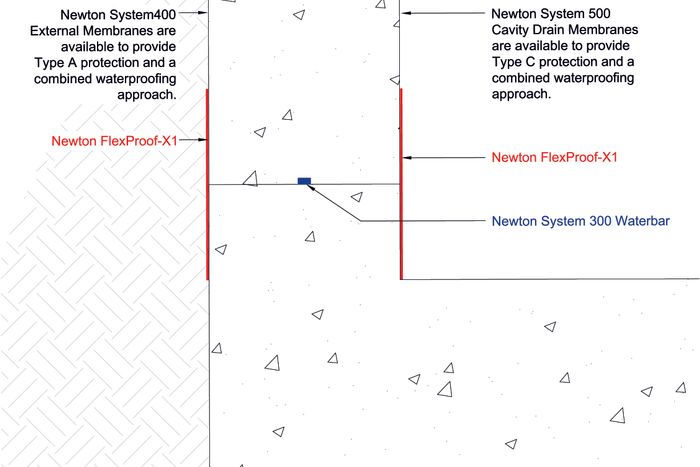 A below-ground concrete structure that uses waterbars and joint protection at the kicker joint is able to achieve Type B waterproofing structure, suitable for a Grade 1 internal environment.
A below-ground concrete structure that uses waterbars and joint protection at the kicker joint is able to achieve Type B waterproofing structure, suitable for a Grade 1 internal environment.
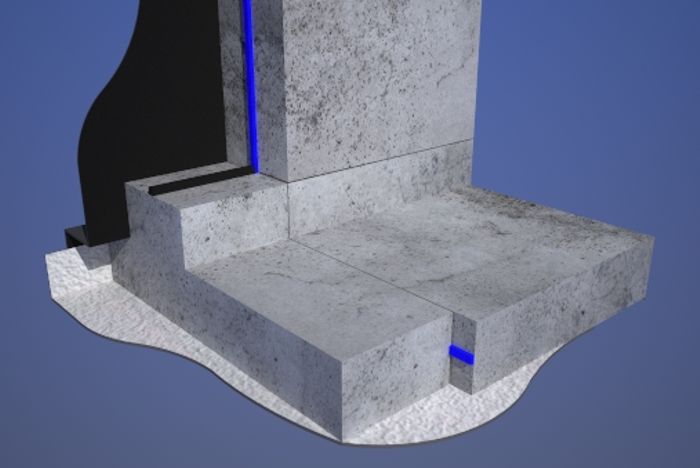 A concrete structure that employs both a Type A external waterproofing membrane and Type B waterbars at the construction joints, may create a below-ground structure that is suitable for all three grades of internal environment.
A concrete structure that employs both a Type A external waterproofing membrane and Type B waterbars at the construction joints, may create a below-ground structure that is suitable for all three grades of internal environment.
Admixtures and Type B
As a standalone solution, a Type B structure is generally only suitable for areas that require a Grade 1 internal environment, or where the water table is below the internal level of the slab or raft. However, it is a brave person who bets that water will never come to bear against a below-ground structure at some point in its life.
Case history also makes it impossible to guarantee faultless installation, with the 1999 Outwing v Weatherald High Court judgment ruling that it is “not reasonable to expect 100% defect-free workmanship”.
Considering that Type B structures provide a barrier against positive hydrostatic pressure, such a structure must be inherently defect-free in order to be effective. However, the precedent set by Outwing v Weatherald means that we have to expect imperfections and, therefore, a risk of leaking.
Common defects in Type B structures include voids and capillaries left by poor compaction or poor/high water:cement ratios, badly installed construction joint accessories and the many forms of cracking. However, as already discussed, admixtures cannot fully prevent nor protect against such defects.
In order to achieve an effective Type B structure alongside well-designed concrete and waterbars, there are instead some alternative and proactive techniques that can be used to form an effective means of protecting potential points of water ingress.
First, by installing an injectable waterbar system, either standalone or alongside a hydrophilic waterbar, a maintainable system is achieved, allowing for the retrospective injection of leaking construction joints, to be used as a remedial treatment.
Second, by installing an external Type A system alongside the Type B structure, a combined waterproofing solution is achieved, with the Type A membrane providing additional protection to the key critical construction joints and cracks. Even with the most technologically advanced, self-healing hydrophilic Type A membranes, which mechanically bond to the cast-in-situ concrete, it would be worth considering the technical benefits and the cost per square metre in comparison with the addition of the aforementioned admixtures.
References:
1. BRITISH STANDARDS INSTITUTION, BS 8102:2022. Code of practice for the protection of below ground structures against water ingress. BSI, London, March 2022.
2. NATIONAL HOUSE BUILDING COUNCIL. NHBC Standards 2016, Chapter 5.4, Waterproofing of basements and other below ground structures. NHBC, Milton Keynes, October 2014.
3. BRITISH STANDARDS INSTITUTION, BS EN 1992-1-1. Eurocode 2. Design of concrete structures. General rules and rules for buildings. BSI, London, 2004.
Speak to our friendly, expert team
Our staff are able to provide guidance for projects of all sizes, whether you require some general advice about damp or waterproofing, or support with technical drawings and specifications.













